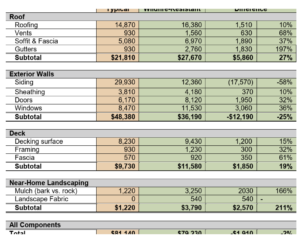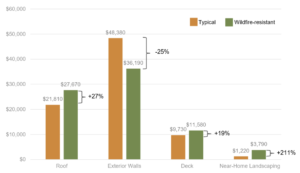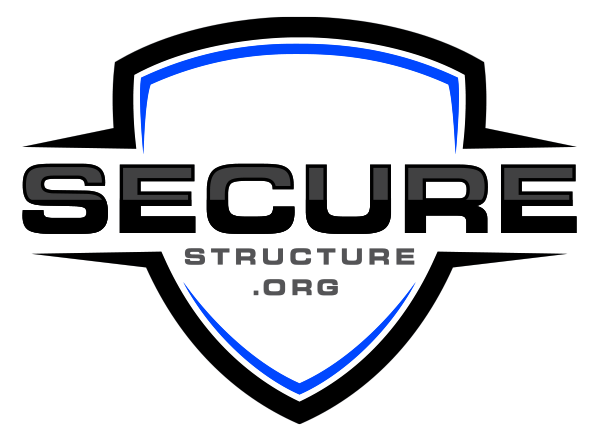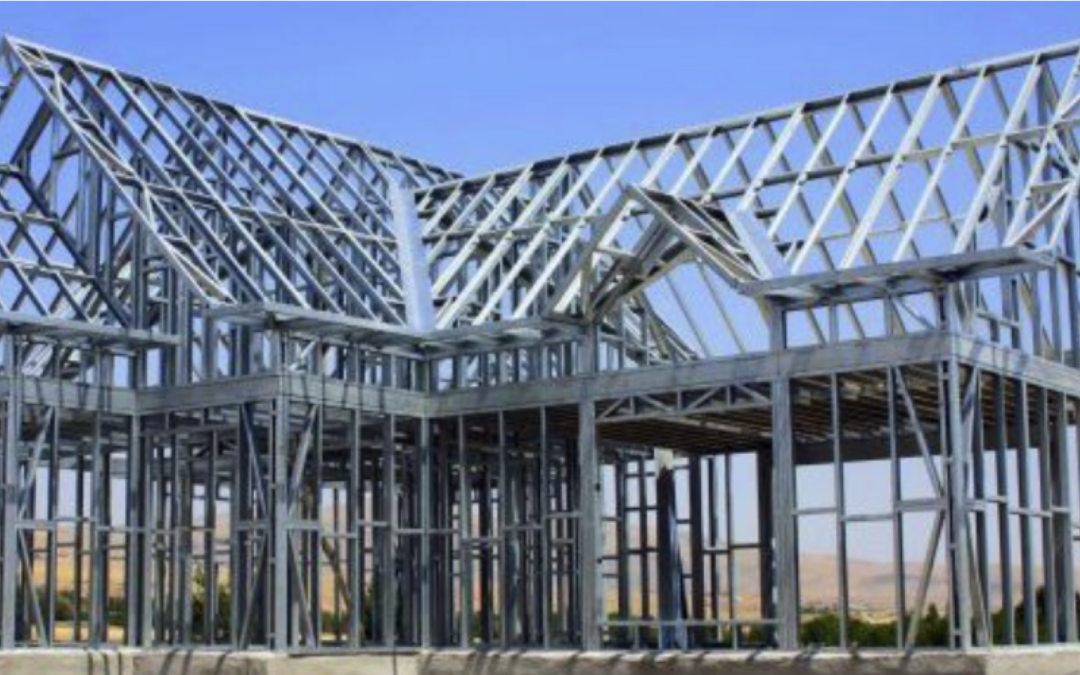Hazard-Resistant Building Materials for a Safer Future: Protect Your Home from Natural Disasters
In an increasingly unpredictable world, ensuring your home withstands the forces of nature is more vital than ever. From hurricanes to earthquakes, the threat of natural disasters looms large, prompting homeowners to rethink traditional building choices. Enter the realm of hazard-resistant building materials—innovations designed not only to protect but to secure peace of mind. This article explores the top 10 materials that promise to fortify your home against nature’s wrath, enhancing safety while preserving aesthetic appeal. Discover how investing in these resilient materials can transform your home into a fortress, safeguarding your loved ones and your investment. Join us as we unveil ingenious solutions that set a new standard in home construction, paving the way for a safer, more resilient future. Whether you’re building from the ground up or renovating an existing structure, these materials offer the durability and security needed to weather any storm. Let’s take a closer look at how you can protect your home today!

Understanding Natural Disasters and Their Impact on Homes
Natural disasters, such as hurricanes, earthquakes, floods, and wildfires, have a devastating impact on homes and communities. These events can strike with little warning, causing extensive damage and disruption. The sheer force of these disasters can lead to the destruction of property, displacement of families, and, tragically, loss of life. Understanding the specific threats posed by various natural disasters is crucial for homeowners aiming to protect their properties. Each type of disaster presents unique challenges, necessitating tailored approaches to building and fortification.
Hurricanes, for instance, bring high winds and heavy rains that can tear roofs off houses, shatter windows, and cause flooding. Earthquakes, on the other hand, shake structures to their foundations, testing the flexibility and strength of building materials. Floods can submerge homes, leading to structural damage and mold growth, while wildfires can engulf entire neighborhoods in flames, reducing homes to ashes. The aftermath of these events often leaves communities grappling with extensive rebuilding efforts and significant financial burdens.
Protecting homes from these natural calamities requires a proactive approach to construction and renovation. By integrating hazard-resistant building materials, homeowners can significantly enhance the resilience of their properties. These materials are designed to withstand the forces of nature, providing a robust defense against the unpredictable. As we delve into the top 10 hazard-resistant building materials, it becomes evident that these innovations are not just about safeguarding structures but also about ensuring peace of mind for homeowners.

Criteria for Choosing Hazard-Resistant Building Materials
Selecting the right hazard-resistant materials involves several critical criteria. First and foremost, the material’s ability to withstand specific natural disasters is paramount. For example, materials that are resistant to high winds and impact are essential in hurricane-prone areas, while those with high thermal resistance are crucial in regions susceptible to wildfires. The durability and longevity of the material also play a vital role, as homeowners need assurances that their investments will stand the test of time.
Another important criterion is the ease of maintenance and repair. Materials that require minimal upkeep and can be easily repaired or replaced in the event of damage are highly desirable. This ensures that homeowners can manage their properties efficiently and cost-effectively over the long term. Additionally, the environmental impact of the materials should be considered. Sustainable and eco-friendly options are increasingly preferred, as they contribute to the overall well-being of the planet while providing robust protection.
Cost is another significant factor. While hazard-resistant materials might come with a higher initial price tag compared to traditional options, their long-term benefits often offset the upfront costs. It’s essential to weigh the potential savings in terms of reduced repair and replacement expenses, lower insurance premiums, and the invaluable peace of mind that comes with knowing your home is well-protected. Balancing these criteria will help homeowners make informed decisions, ensuring that their choices align with both their safety needs and their budget.
Top 10 Hazard-Resistant Building Materials
1. Reinforced Concrete
Reinforced concrete stands out as a premier choice for hazard-resistant building materials. By integrating steel reinforcement bars (rebar) into concrete, this material gains exceptional strength and flexibility, making it highly resistant to earthquakes and high winds. Its durability ensures that structures remain intact even under extreme stress, providing a reliable barrier against natural disasters. Additionally, reinforced concrete is fire-resistant, further enhancing its protective capabilities.
2. Steel Framing
Steel framing offers a robust alternative to traditional wood framing, particularly in regions prone to earthquakes, hurricanes, and termites. Steel’s inherent strength and flexibility allow it to absorb and dissipate energy from seismic activity, reducing the risk of structural failure. Moreover, steel is non-combustible, adding a layer of protection against fires. Its resistance to pests and decay ensures longevity, making it a wise investment for homeowners seeking durable hazard-resistant building materials.
3. Impact-Resistant Windows
Impact-resistant windows are engineered to withstand the force of flying debris during hurricanes and severe storms. These windows feature multiple layers of glass and a durable interlayer that holds the glass in place even when shattered. This design not only protects against breakage but also prevents water and wind from entering the home, reducing the risk of interior damage. Additionally, impact-resistant windows enhance security by deterring break-ins.
4. Fiber Cement Siding
Fiber cement siding combines the best of both worlds: the aesthetic appeal of traditional wood siding and the resilience of modern materials. Composed of cement, sand, and cellulose fibers, this siding is highly resistant to fire, termites, and rot. Its ability to withstand harsh weather conditions, including high winds and heavy rain, makes it an excellent choice for homes in disaster-prone areas. Furthermore, fiber cement siding requires minimal maintenance and offers a long lifespan.
5. Concrete Masonry Units (CMUs)
Concrete masonry units, or CMUs, are a versatile and durable building material often used in the construction of walls and foundations. These blocks are highly resistant to wind, fire, and seismic activity, making them ideal for hazard-resistant construction. CMUs can be reinforced with steel and filled with grout to enhance their strength and stability. Their thermal mass properties also contribute to energy efficiency, helping to regulate indoor temperatures.
6. Roofing Shingles
High-quality roofing shingles, such as those made from asphalt or metal, provide a critical layer of protection for homes. Impact-resistant shingles are specifically designed to withstand hailstorms and flying debris, preventing roof damage and leaks. Metal roofing, in particular, offers superior fire resistance and longevity, making it a popular choice in wildfire-prone areas. Proper installation and maintenance of roofing materials are essential to ensure optimal performance.
7. Fire-Resistant Insulation
Fire-resistant insulation is a crucial component of hazard-resistant homes, particularly in regions susceptible to wildfires. Hazard-resistant building materials such as mineral wool and fiberglass are non-combustible and can withstand high temperatures without igniting. This insulation not only enhances fire safety but also improves energy efficiency by reducing heat loss. Additionally, fire-resistant insulation can help contain fires within specific areas, minimizing overall damage to the home.
8. Hurricane Straps and Ties
Hurricane straps and ties are essential for securing roofs and walls to the foundation of a home, providing critical reinforcement against high winds and storms. These metal connectors are designed to anchor the structural elements of a building, preventing them from being lifted or displaced during extreme weather events. Properly installed hurricane straps and ties significantly reduce the risk of structural failure, ensuring that homes remain standing in the face of hurricanes and tornadoes.
9. Flood-Resistant Materials
Flood-resistant materials, such as water-resistant drywall, closed-cell spray foam insulation, and ceramic tiles, are essential for homes in flood-prone areas. These materials are designed to withstand exposure to water without sustaining significant damage. Water-resistant drywall, for instance, resists mold growth and can be easily cleaned and dried after a flood. Closed-cell spray foam insulation acts as a barrier to water infiltration, while ceramic tiles provide a durable and easy-to-clean flooring option.
10. Fire-Resistant Cladding
Fire-resistant cladding, such as metal panels, fiber cement boards, and stone veneer, plays a vital role in protecting homes from wildfires. These materials are designed to resist ignition and prevent the spread of flames, providing a crucial defense against fire. Metal panels, for example, do not burn and can help shield the underlying structure from heat and embers. Fiber cement boards and stone veneer offer similar fire-resistant properties while adding aesthetic appeal to the home.
Advantages of Using Hazard-Resistant Building Materials
The use of hazard-resistant building materials offers numerous advantages, beginning with enhanced safety and protection. Homes constructed with these materials are better equipped to withstand the forces of nature, reducing the risk of structural damage and protecting the lives of occupants. This increased resilience translates to greater peace of mind for homeowners, knowing that their properties are fortified against natural disasters.
Another significant advantage is the potential for cost savings over time. While the initial investment in hazard-resistant building materials may be higher, the long-term benefits often outweigh the costs. Reduced repair and replacement expenses, lower insurance premiums, and decreased maintenance requirements contribute to overall savings. Additionally, the durability and longevity of these materials mean that homes remain in good condition for longer periods, preserving their value and reducing the need for frequent renovations.
Hazard-resistant building materials also contribute to environmental sustainability. Many of these materials are designed to be energy-efficient, reducing the consumption of resources and lowering utility bills. Furthermore, the use of eco-friendly and sustainable options, such as fiber cement siding and fire-resistant insulation, minimizes the environmental impact of construction. By choosing hazard-resistant materials, homeowners can enhance the resilience of their properties while promoting a greener future.
Cost Considerations for Hazard-Resistant Building Materials
When evaluating hazard-resistant building materials, it’s essential to consider the cost implications. The initial expense of these materials is often higher than that of traditional options. However, this upfront investment can be justified by the long-term benefits they offer. For instance, reinforced concrete and steel framing may be more costly than wood, but their durability and resistance to natural disasters can lead to significant savings on repairs and replacements over time.
Insurance premiums can also be positively impacted by the use of hazard-resistant building materials. Many insurance companies offer discounts or lower rates for homes constructed with materials that enhance safety and reduce the risk of damage. This reduction in insurance costs can help offset the initial investment, making hazard-resistant building materials a financially sound choice for homeowners. Additionally, the peace of mind that comes with knowing your home is well-protected is invaluable.
It’s important to consider the potential for increased property value when using hazard-resistant building materials. Homes built with these materials are often seen as more desirable and secure, attracting potential buyers and increasing market value. The durability and longevity of hazard-resistant building materials mean that homes remain in good condition for longer, preserving their value and appeal. While the initial cost may be higher, the long-term benefits and potential for increased property value make hazard-resistant building materials a wise investment.
Case Studies: Successful Implementation of Hazard-Resistant Building Materials
One notable case study involves a coastal community in Florida that faced frequent hurricane threats. A local builder decided to construct homes using reinforced concrete and impact-resistant windows. These homes successfully withstood multiple hurricanes, sustaining minimal damage compared to neighboring properties. The use of hazard-resistant materials not only protected the homes but also provided peace of mind to the residents, demonstrating the effectiveness of these innovations in real-world scenarios.
Another case study highlights a community in California prone to wildfires. A developer chose to build homes with fire-resistant cladding, metal roofing, and fire-resistant insulation. When a wildfire swept through the area, these homes remained largely unscathed, while traditional wood-framed homes suffered extensive damage. The successful implementation of hazard-resistant materials in this community underscored their importance in protecting lives and properties from fire-related disasters.
In an earthquake-prone region of Japan, a residential complex was constructed using steel framing and reinforced concrete. During a significant earthquake, the buildings experienced minimal structural damage, proving the effectiveness of these materials in withstanding seismic activity. The residents were able to remain in their homes, avoiding displacement and costly repairs. This case study highlights the critical role of hazard-resistant materials in enhancing the resilience of buildings in earthquake-prone areas.
Future Trends in Hazard-Resistant Construction
As the threat of natural disasters continues to grow, the construction industry is evolving to meet the demands for safer, more resilient homes. One emerging trend is the development of smart materials that can adapt to changing conditions. These materials, such as self-healing concrete and phase-change materials, have the ability to repair themselves or alter their properties in response to environmental stressors, providing enhanced protection and longevity.
Another trend is the integration of technology into hazard-resistant construction. Advanced sensors and monitoring systems can detect structural weaknesses and potential threats, allowing for proactive maintenance and repairs. These technologies can also provide real-time data during disasters, helping homeowners and emergency responders make informed decisions. The combination of hazard-resistant materials and smart technology is paving the way for a new era of resilient construction.
Sustainability is also playing a significant role in the future of hazard-resistant construction. The use of eco-friendly materials and sustainable building practices is becoming increasingly important as homeowners and builders seek to reduce their environmental impact. Innovations such as recycled materials, green roofs, and energy-efficient designs are being incorporated into hazard-resistant construction, creating homes that are not only safe but also environmentally responsible.
Tips for Homeowners: How to Select the Right Materials
When selecting hazard-resistant materials, homeowners should start by assessing the specific risks in their area. Understanding the types of natural disasters that are most likely to occur will help guide the selection process. For example, homes in hurricane-prone areas should prioritize impact-resistant windows and reinforced concrete, while those in wildfire-prone regions should focus on fire-resistant cladding and insulation.
It’s also important to consider the overall design and aesthetic of the home. Hazard-resistant materials come in a variety of styles and finishes, allowing homeowners to choose options that complement their architectural preferences. Working with a knowledgeable contractor or architect can help ensure that the chosen materials not only provide protection but also enhance the visual appeal of the home.
Budget considerations are crucial when selecting hazard-resistant building materials. Homeowners should weigh the initial costs against the long-term benefits, including potential savings on repairs, insurance premiums, and maintenance. Exploring financing options and government incentives for resilient construction can also help make these materials more accessible. Consulting with insurance providers to understand the potential impact on premiums can provide additional insights into the financial advantages of hazard-resistant building materials.
Conclusion: Building a Safer Future with Hazard-Resistant Materials
Investing in hazard-resistant building materials is a proactive step towards creating a safer and more resilient future. These materials offer unparalleled protection against natural disasters, safeguarding homes and the lives of those within them. From reinforced concrete and steel framing to impact-resistant windows and fire-resistant cladding, the innovations in construction materials are setting new standards in safety and durability.
The benefits of hazard-resistant building materials extend beyond immediate protection. They offer long-term cost savings through reduced repair and maintenance expenses, lower insurance premiums, and increased property value. The environmental advantages of sustainable and energy-efficient materials further enhance their appeal, contributing to a greener and more responsible approach to construction.
As we look to the future, the integration of smart technologies and sustainable practices will continue to shape the landscape of hazard-resistant construction. Homeowners who embrace these advancements can enjoy the peace of mind that comes with knowing their homes are well-protected against the forces of nature. By making informed choices and investing in resilient materials, we can build a safer, more secure future for ourselves and our communities.


